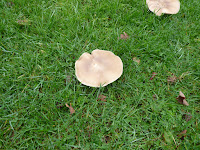I have a theory that modern foods have changed our perception of edibility. Presentation of food is more important than taste and we have grown used to bland foods enhanced by sugar, salt and other additives. Thus the humble Field Blewit's plainness hides a secret. It is an excellent mushroom for the pot or pan! Not only that but it is able to withstand frost and cold making it available to the forager right into the new year long after other field fungi have disappeared into a mush.
The only downside is that it has a great ability to absorb water. Pick one after a wet spell and squeeze like you would a sponge to see what I mean. All that means is you have to either pick after a dry spell or dry it out a little before you cook. If going into the pot to enhance a stew then no problem.
Note the bulbous base to the stem and the white, crowded gills. If you smell one it is highly perfumed. The taste is strong but pleasant.
If you take a spore print the deposit will be pink.
In the picture below you can make out the way these Blewits are in a large fairy ring. I'll post something about how these form when I have time.




No comments:
Post a Comment